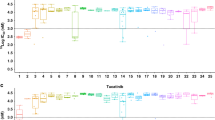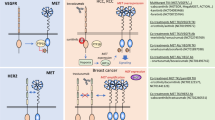Abstract
The epidermal growth factor receptor (EGFR) is a central regulator of proliferation and progression in human cancers. Five EGFR inhibitors, two monoclonal antibodies and three TKIs, have recently gained FDA approval in oncology (cetuximab, panitumumab, erlotinib, gefitinib and lapatinib). These strategies of EGFR inhibition demonstrate major tumor regressions in approximately 10–20% of advanced cancer patients. However, many tumors eventually manifest acquired resistance to treatment. In this study we established and characterized a model to study molecular mechanisms of acquired resistance to the EGFR monoclonal antibody cetuximab. Using high-throughput screening we examined the activity of 42 receptor tyrosine kinases in resistant tumor cells following chronic exposure to cetuximab. Cells developing acquired resistance to cetuximab exhibited increased steady-state EGFR expression secondary to alterations in trafficking and degradation. In addition, cetuximab-resistant cells manifested strong activation of HER2, HER3 and cMET. EGFR upregulation promoted increased dimerization with HER2 and HER3 leading to their transactivation. Blockade of EGFR and HER2 led to loss of HER3 and PI(3)K/Akt activity. These data suggest that acquired resistance to cetuximab is accompanied by dysregulation of EGFR internalization/degradation and subsequent EGFR-dependent activation of HER3. Taken together these findings suggest a rationale for the clinical evaluation of combinatorial anti-HER targeting approaches in tumors manifesting acquired resistance to cetuximab.
This is a preview of subscription content, access via your institution
Access options
Subscribe to this journal
Receive 50 print issues and online access
$259.00 per year
only $5.18 per issue
Buy this article
- Purchase on Springer Link
- Instant access to full article PDF
Prices may be subject to local taxes which are calculated during checkout








Similar content being viewed by others
Abbreviations
- DMSO:
-
dimethyl sulfoxide
- EGFR:
-
epidermal growth factor receptor
- ELISA:
-
enzyme-linked immunosorbent assay
- HGF:
-
hepatocyte growth factor
- mAb:
-
monoclonal antibody
- MAPK:
-
mitogen-activated protein kinase
- NSCLC:
-
nonsmall cell lung cancer
- PI(3)K:
-
phosphatidylinositol 3′-kinase
- RTK:
-
receptor tyrosine kinase
- SCC:
-
squamous cell carcinoma
- TKD:
-
tyrosine kinase domain
- TKI:
-
tyrosine kinase inhibitor
References
Baselga J, Arteaga CL . (2005). Critical update and emerging trends in epidermal growth factor receptor targeting in cancer. J Clin Oncol 23: 2445–2459.
Benavente S, Huang S, Armstrong E, Chi A, Chinnaiyan P, Harari PM . (2004). Establishment of acquired resistance to epidermal growth factor receptor (EGFR) inhibitors in human tumor cell lines. AACR Meeting Abstracts 2004: 1230a.
Bonner JA, Harari PM, Giralt J, Azarnia N, Shin DM, Cohen RB et al. (2006). Radiotherapy plus cetuximab for squamous-cell carcinoma of the head and neck. N Engl J Med 354: 567–578.
Christensen JG, Schreck R, Burrows J, Kuruganti P, Chan E, Le P et al. (2003). A selective small molecule inhibitor of c-Met kinase inhibits c-Met-dependent phenotypes in vitro and exhibits cytoreductive antitumor activity in vivo. Cancer Res 63: 7345–7355.
Ciardiello F, Bianco R, Caputo R, Caputo R, Damiano V, Troiani T et al. (2004). Antitumor activity of ZD6474, a vascular endothelial growth factor receptor tyrosine kinase inhibitor, in human cancer cells with acquired resistance to antiepidermal growth factor receptor therapy. Clin Cancer Res 10: 784–793.
Citri A, Skaria KB, Yarden Y . (2003). The deaf and the dumb: the biology of ErbB-2 and ErbB-3. Exp Cell Res 284: 54–65.
Citri A, Yarden Y . (2006). EGF-ERBB signalling: towards the systems level. Nat Rev Mol Cell Biol 7: 505–516.
Cunningham D, Humblet Y, Siena S, Khayat D, Bleiberg H, Santoro A et al. (2004). Cetuximab monotherapy and cetuximab plus irinotecan in irinotecan-refractory metastatic colorectal cancer. N Engl J Med 351: 337–345.
Engelman JA, Zejnullahu K, Mitsudomi T, Song Y, Hyland C, Park JO et al. (2007). MET amplification leads to gefitinib resistance in lung cancer by activating ERBB3 signaling. Science 316: 1039–1043.
Erjala K, Sundvall M, Junttila TT, Zhang N, Savisalo M, Mali P et al. (2006). Signaling via ErbB2 and ErbB3 associates with resistance and epidermal frowth factor receptor (EGFR) amplification with sensitivity to EGFR inhibitor gefitinib in head and neck squamous cell carcinoma cells. Clin Cancer Res 12: 4103–4111.
Franklin MC, Carey KD, Vajdos FF, Leahy DJ, De Vos AM, Sliwkowski MX . (2004). Insights into ErbB signaling from the structure of the ErbB2-pertuzumab complex. Cancer Cell 5: 317–328.
Fujimoto N, Wislez M, Zhang J, Iwanaga K, Dackor J, Hanna AE et al. (2005). High expression of ErbB family members and their ligands in lung adenocarcinomas that are sensitive to inhibition of epidermal growth factor receptor. Cancer Res 65: 11478–11485.
Furukawa M, Nagatomo I, Kumagai T, Yamadori T, Takahashi R, Yoshimura M et al. (2007). Gefitinib-sensitive EGFR lacking residues 746–750 exhibits hypophosphorylation at tyrosine residue 1045, hypoubiquitination, and impaired endocytosis. DNA Cell Biol 26: 178–185.
Gondi V, Huang S, Benavente S, Armstrong E, Harari PM . (2006). Potential mechanisms of acquired Resistance to EGFR inhibitors. AACR Meeting Abstracts 2006: 294b.
Grandal MV, Zandi R, Pedersen MW, Willumsen BM, van Deurs B, Poulsen HS . (2007). EGFRvIII escapes down-regulation due to impaired internalization and sorting to lysosomes. Carcinogenesis 28: 1408–1417.
Grovdal LM, Stang E, Sorkin A, Madshus IH . (2004). Direct interaction of Cbl with pTyr 1045 of the EGF receptor (EGFR) is required to sort the EGFR to lysosomes for degradation. Exp Cell Res 300: 388–395.
Han W, Zhang T, Yu H, Foulke JG, Tang CK . (2006). Hypophosphorylation of residue Y1045 leads to defective downregulation of EGFRvIII. Cancer Biol Ther 5: 1361–1368.
Huang S, Armstrong EA, Benavente S, Chinnaiyan P, Harari PM . (2004). Dual-agent molecular targeting of the epidermal growth factor receptor (EGFR): combining anti-EGFR antibody with tyrosine kinase inhibitor. Cancer Res 64: 5355–5362.
Matar P, Rojo F, Cassia R, Moreno-Bueno G, Di Cosimo S, Tabernero J et al. (2004). Combined epidermal growth factor receptor targeting with the tyrosine kinase inhibitor gefitinib (ZD1839) and the monoclonal antibody cetuximab (IMC-C225): superiority over single-agent receptor targeting. Clin Cancer Res 10: 6487–6501.
Mendelsohn J . (2003). Antibody-mediated EGF receptor blockade as an anticancer therapy: from the laboratory to the clinic. Cancer Immunol Immunother 52: 342–346.
Mendelsohn J, Baselga J . (2006). Epidermal growth factor receptor targeting in cancer. Semin Oncol 33: 369–385.
Mukohara T, Engelman JA, Hanna NH, Yeap BY, Kobayashi S, Lindeman N et al. (2005). Differential effects of gefitinib and cetuximab on non-small-cell lung cancers bearing epidermal growth factor receptor mutations. J Natl Cancer Inst 97: 1185–1194.
Pao W, Miller VA, Politi KA, Riely GJ, Somwar R, Zakowski MF et al. (2005). Acquired resistance of lung adenocarcinomas to gefitinib or erlotinib is associated with a second mutation in the EGFR kinase domain. PLoS Med 2: 1–11.
Peruzzi B, Bottaro DP . (2006). Targeting the c-Met signaling pathway in cancer. Clin Cancer Res 12: 3657–3660.
Reid A, Vidal L, Shaw H, De Bono J . (2007). Dual inhibition of ErbB1 (EGFR/HER1) and ErbB2 (HER2/neu). Eur J Cancer 43: 481–489.
Ritter CA, Perez-Torres M, Rinehart C, Guix M, Dugger T, Engelman JA et al. (2007). Human breast cancer cells selected for resistance to trastuzumab in vivo overexpress epidermal growth factor receptor and ErbB ligands and remain dependent on the ErbB receptor network. Clin Cancer Res 13: 4909–4919.
Sequist LV, Bell DW, Lynch TJ, Haber DA . (2007). Molecular predictors of response to epidermal growth factor receptor antagonists in non-small-cell lung cancer. J Clin Oncol 25: 587–595.
Sergina NV, Rausch M, Wang D, Blair J, Hann B, Shokat KM et al. (2007). Escape from HER-family tyrosine kinase inhibitor therapy by the kinase-inactive HER3. Nature 445: 437–441.
Sunada H, Magun BE, Mendelsohn J, MacLeod CL . (1986). Monoclonal antibody against epidermal growth factor receptor is internalized without stimulating receptor phosphorylation. Proc Natl Acad Sci USA 83: 3825–3829.
Zhou BB, Peyton M, He B, Liu C, Girard L, Caudler E et al. (2006). Targeting ADAM-mediated ligand cleavage to inhibit HER3 and EGFR pathways in non-small cell lung cancer. Cancer Cell 10: 39–50.
Acknowledgements
We thank AstraZeneca (gefitinib), Genentech (erlotinib, 2C4), ImClone (cetuximab), OSI (erlotinib) and Pfizer Global Research (PHA665752 and CI-1033) for supplying EGFR- and cMET-targeting agents. This work was supported in part by NIH R01 CA 113448-01 (PMH) and American Cancer Society Postdoctoral Fellowship (DLW).
Author information
Authors and Affiliations
Corresponding author
Rights and permissions
About this article
Cite this article
Wheeler, D., Huang, S., Kruser, T. et al. Mechanisms of acquired resistance to cetuximab: role of HER (ErbB) family members. Oncogene 27, 3944–3956 (2008). https://doi.org/10.1038/onc.2008.19
Received:
Revised:
Accepted:
Published:
Issue Date:
DOI: https://doi.org/10.1038/onc.2008.19
Keywords
This article is cited by
-
PANTHER: AZD8931, inhibitor of EGFR, ERBB2 and ERBB3 signalling, combined with FOLFIRI: a Phase I/II study to determine the importance of schedule and activity in colorectal cancer
British Journal of Cancer (2023)
-
Depleting receptor tyrosine kinases EGFR and HER2 overcomes resistance to EGFR inhibitors in colorectal cancer
Journal of Experimental & Clinical Cancer Research (2022)
-
HER3 in cancer: from the bench to the bedside
Journal of Experimental & Clinical Cancer Research (2022)
-
miR-199b-3p contributes to acquired resistance to cetuximab in colorectal cancer by targeting CRIM1 via Wnt/β-catenin signaling
Cancer Cell International (2022)
-
Molecular mechanism(s) of regulation(s) of c-MET/HGF signaling in head and neck cancer
Molecular Cancer (2022)



